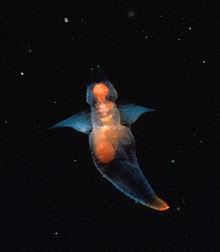- Clionidae
-
Clionidae 
Clione limacina Scientific classification Kingdom: Animalia Phylum: Mollusca Class: Gastropoda (unranked): clade Heterobranchia
clade Euthyneura
clade Euopisthobranchia
clade GymnosomataSuperfamily: Clionoidea Family: Clionidae
Rafinesque, 1815Clionidae is a family of sea angels, which are a group of pelagic marine gastropods.
They are shaped a little like angels, and have flapping "wings", hence their common name. They are gelatinous, mostly transparent pteropods, and they only have shells in their embryonic stage. They are mostly very small, with the largest species (Clione limacina) reaching 5 centimeters (2 in).
Contents
External anatomy
The Clionidae use winglike flaps for rhythmical locomotion, as if flying in the sea. These "wings" are attached to the anterior part of the body. The posterior part is gelatinous and mostly transparent.
The orange visceral sac is confined to the anterior part.
Life habits
Mating is carried out ventrally for mutual fertilization. The following spring, this results in a free-floating, gelatinous egg mass.
Taxonomy
Clionidae d'Orbigny, 1851 is unfortunately also the name of a family of sponges in the order Hadromerida, class Demospongiae. Within the ICZN there has been a proposed emendation of spelling to Clionaidae for the sponge family. The ICZN has ruled that the correct name of gastropod family is Clionidae Gray, 1847, with type genus Clione Pallas, 1774.[1][2]
The following two subfamilies have been recognized in the taxonomy of Bouchet & Rocroi (2005):
- subfamily Clioninae Rafinesque, 1815 - synonyms: Fowlerininae Pruvot-Fol, 1926
- subfamily Thliptodontinae, Kwietniewski, 1902 - synonyms: Pteroceanidae Meisenheimer, 1902; Cephalobranchiinae Pruvot-Fol, 1926
Genera
Genera within the family Clionidae include:
subfamily Clioninae
subfamily Thliptodontinae
subfamily ?
- Paedoclione Danforth, 1907[6] - with the only species Paedoclione doliiformis Danforth, 1907[7]
- Paraclione Tesch, 1903[8]
- Thalassopterus Kwietniewski, 1910 - with the only species Thalassopterus zancleus Kwietniewski, 1910[9]
References
- ^ International Commission on Zoological Nomenclature (30 September 2004). "Comments". Bulletin of Zoological Nomenclature 61 (3). http://64.233.183.104/search?q=cache:4FDiEN7_o_8J:www.iczn.org/BZNSeptember2004comments.htm+Cliidae+Clionidae&hl=nl&ct=clnk&cd=1&gl=be&lr=lang_en.
- ^ Comment on the proposal to emend the spelling of CLIONIDAE d'Orbigny, 1851 (Porifera, Hadromerida) to CLIONAIDAE to remove homonymy with CLIONIDAE Rafinesque, 1815 (Mollusca); (Case 3211; see BZN 60: 99-102)[dead link]
- ^ WoRMS (2009). Fowlerina Pelseneer, 1906. In: Bouchet, P.; Gofas, S.; Rosenberg, G. World Marine Mollusca database. Accessed through the World Register of Marine Species at http://marinespecies.org/aphia.php?p=taxdetails&id=137794 on 2010-09-
- ^ WoRMS (2010). Cephalobrachia. Accessed through: World Register of Marine Species at http://www.marinespecies.org/aphia.php?p=taxdetails&id=416184 on 2010-09-16
- ^ WoRMS (2010). Thliptodon Boas, 1886. In: Bouchet, P.; Gofas, S.; Rosenberg, G. (2010) World Marine Mollusca database. Accessed through: World Register of Marine Species at http://www.marinespecies.org/aphia.php?p=taxdetails&id=137797 on 2010-09-16
- ^ WoRMS (2010). Paedoclione Danforth, 1907. Accessed through: World Register of Marine Species at http://www.marinespecies.eu/aphia.php?p=taxdetails&id=160432 on 2010-09-16
- ^ "Genus Paedoclione". Marine Species Identification Portal, accessed 4 February 2011.
- ^ WoRMS (2009). Paraclione Tesch, 1903. In: Bouchet, P.; Gofas, S.; Rosenberg, G. World Marine Mollusca database. Accessed through the World Register of Marine Species at http://www.marinespecies.org/aphia.php?p=taxdetails&id=137795 on 2010-09-16
- ^ Gofas, S. (2009). Thalassopterus zancleus Kwietniewski, 1910. In: Bouchet, P.; Gofas, S.; Rosenberg, G. World Marine Mollusca database. Accessed through the World Register of Marine Species at http://www.marinespecies.org/aphia.php?p=taxdetails&id=139183 on 2010-09-16
External links
Categories:
Wikimedia Foundation. 2010.
